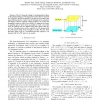Free Online Productivity Tools
i2Speak
i2Symbol
i2OCR
iTex2Img
iWeb2Print
iWeb2Shot
i2Type
iPdf2Split
iPdf2Merge
i2Bopomofo
i2Arabic
i2Style
i2Image
i2PDF
iLatex2Rtf
Sci2ools
ISCAS
2005
IEEE
2005
IEEE
On the three-dimensional channel routing
— The 3-D channel routing is a fundamental problem on the physical design of 3-D integrated circuits. The 3-D channel is a 3-D grid G and the terminals are vertices of G located in the top and bottom layers. A net is a set of terminals to be connected. The object of the 3-D channel routing problem is to connect the terminals in each net with a tree (wire) in G using as few layers as possible and as short wires as possible in such a way that wires for distinct nets are disjoint. This paper shows that any set of n 2-terminal nets can be routed in a 3-D channel with O √ n layers using wires of length O √ n . We also show that there exists a set of n 2-terminal nets that requires a 3-D channel with Ω √ n layers to be routed.
| Added | 25 Jun 2010 |
| Updated | 25 Jun 2010 |
| Type | Conference |
| Year | 2005 |
| Where | ISCAS |
| Authors | Satoshi Tayu, Patrik Hurtig, Yoshiyasu Horikawa, Shuichi Ueno |
Comments (0)

